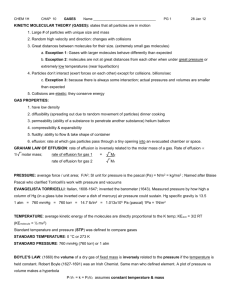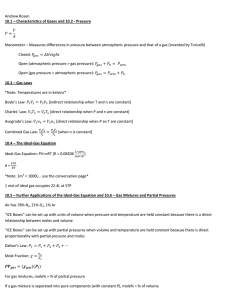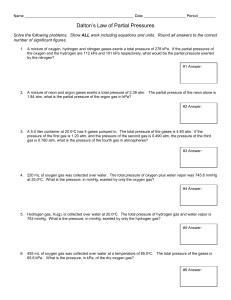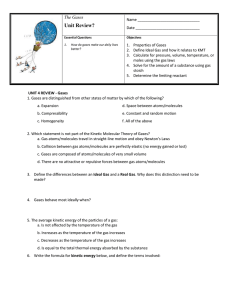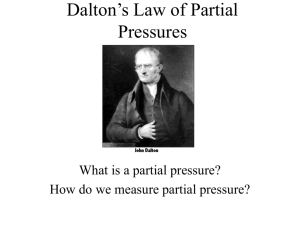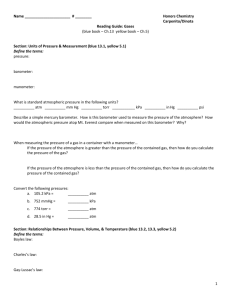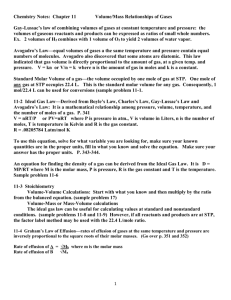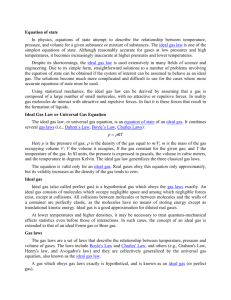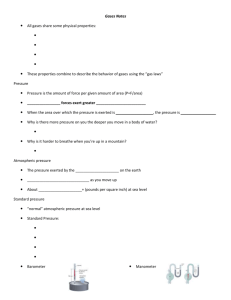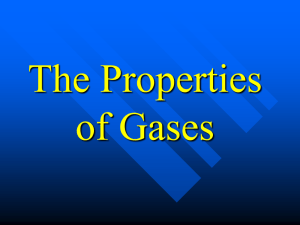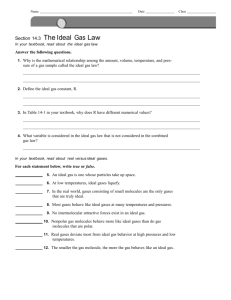The Gaseous State
advertisement
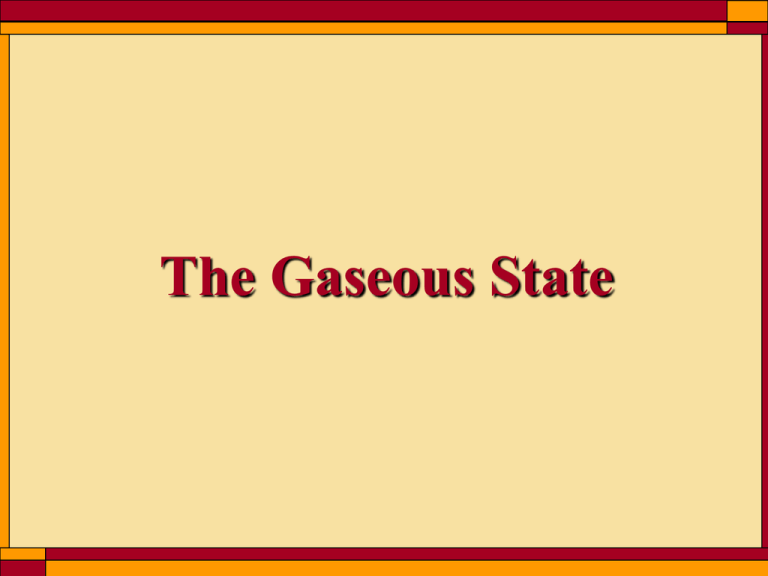
The Gaseous State Gases consist of widely separated molecules in rapid motion. All gases near room temperatures and normal pressures show the same quantitative relationships among their physical properties of pressure, temperature, volume and molar amount. force Pressure = area SI unit of pressure: pascal (Pa) 1Pa = 1N 1m2 = 1kg . m/s2 1kg/m. s2 = 1m2 Standard atmosphere: 1 atm = 101325 Pa = 101.325 kPa Temperature: absolute temperature scale, Kelvin scale K = °C + 273.15 T = t + 273 Boyle’s law: The volume of a sample of gas at a given temperature is found to vary inversely with the applied pressure 1 V P (at fixed temperature for a given amount of gas) PV = constant Pressure – Volume Data for 1.00g O2 at 0°C P (atm) V (L) PV 0.250 0.500 0.750 1.000 2.000 3.000 4.000 5.000 2.801 1.400 0.933 0.699 0.349 0.233 0.174 0.139 0.7003 0.7001 0.6999 0.6998 0.6991 0.6984 0.6977 0.6969 A plot of the volume of 1.000g O2 at 0°C for various pressures. 3 Volume L 2 1.40 L 1 0.70 L 0 0.25 0.50 Pressure (atm) 0.75 1.00 Charles’ Law Relationship between the volume and the temperature of a gas (Jacques Charles, Joseph Gay-Lussac) Variation of the volume of a sample of gas with temperature (p=const.) Temperature °C K 0 273 Volume ml 273 1 274 274 10 273 283 546 283 546 The volume of any sample of a gas varies directly with absolute temperature if the pressure is held constant. V VTor V = kT or =k T The V is not directly proportional to the °C. Vf Vi Tf or Vf = Vi x = Tf Ti Ti Vi = initial volume Vf = final volume Ti = initial temperature Tf = final temperature Volume L Temperature-volume curve for an ideal gas (Charles’ law) -200 -273.15 -100 0 100 Temperature °C 200 Gay-Lussac’s Law At constant volume, the pressure of a given mass of gas varies directly with the absolute temperature. P PTor P = kT or T = k Pf Pi Tf = Ti Combined Gas Law PfVf Pi Vi = Ti Tf Avogadro’s Law (see stoichiometry) V = nVm n = number of moles Vm = molar gas volume (volume of 6.022 x 1023 gas molecules at a given temperature and pressure) Standard temperature and pressure (STP) Temperature : 0°C = 273 K Pressure: 1 atm = 101.325 kPa Molar gas volume at STP: 22.41 L/mol The Ideal Gas Law: 1 V P at fixed T, n Boyle’s Law VT at fixed P, n Charles’ Law Vn a fixed T, P Avogadro’s Law Therefore, 1 V T n P PV = nRT molar gas constant The Ideal Gas Law: 3 PV 101.325 kPa x 22.41 dm = R= = 1 mol x 273.15 K nT 8.314 kPa x dm3 x mol-1x K-1 J Ideal gas: A hypothetical gas that follows the behavior described by the equation of state for an ideal gas. Gas Mixtures: Dalton’s law of partial pressures: the total pressure of a mixture of gases that do not react is equal to the sum of the partial pressures of all the gases present. Ptotal = pA + pB + pC + … Kinetic Theory of an Ideal Gas Postulates: 1. Gases are composed of molecules whose size is negligible compared to the distance between them. 2. Molecules move randomly in linear motion. 3. The collosions are elastic. 4. The average kinetic energy of a molecule is proportional to the K. 0°C Relative number of mulecules Maxwell's distributions of molecular speeds (H2) 500°C 1000 2000 3000 4000 5000 (m/s) Graham’s law of effusion: The rate of effusion of gas molecules from a particular hole is inversely proportional to the square root of the molecular weight of the gas at constant temperature and pressure. Rate of effusion 1 V Mm Real gases Van der Waals equation: n2a P+ V2 V - nb = nRT „a” and „b” are constants
